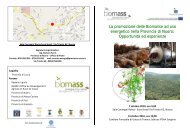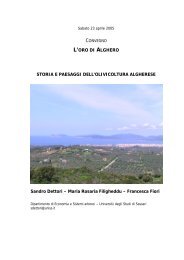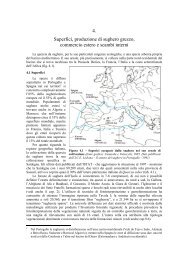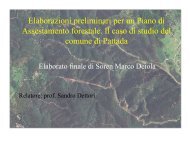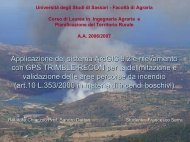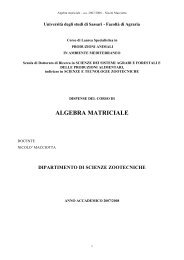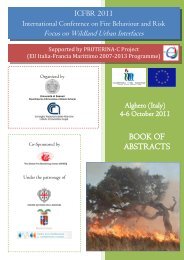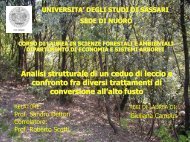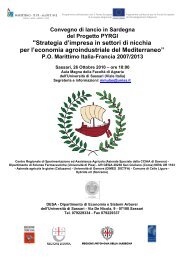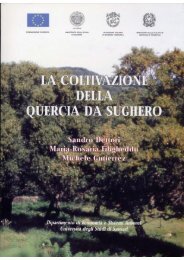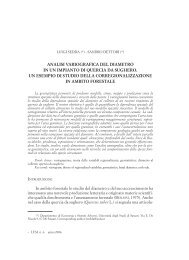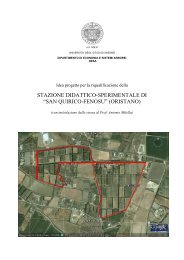Germogliamento e radicazione di talee di vite - Dipartimento di ...
Germogliamento e radicazione di talee di vite - Dipartimento di ...
Germogliamento e radicazione di talee di vite - Dipartimento di ...
Create successful ePaper yourself
Turn your PDF publications into a flip-book with our unique Google optimized e-Paper software.
ICS/NL 19, showed good characteristics regar<strong>di</strong>ng the average yield, juice percentage of fruit and<br />
seed number.<br />
Keywords: Citrus, lemon, varieties, clone, fruit quality.<br />
Nella presente nota vengono illustrati i risultati preliminari <strong>di</strong> una prova su 15 cloni nucellari<br />
<strong>di</strong> limone <strong>di</strong> provenienza americana (“Frost Eureka” e “Frost Lisbon”), sarda (“Rifiorente locale”<br />
ICS/NL 1, ICS/NL 11, ICS/NL 12, ICS/NL 13, ICS/NL 14 e ICS/NL 19) e siciliana (“Femminello<br />
comune” ICP/NL 2, “Femminello Messina” SAA/NL 482, “Femminello siracusano” ICP/NL 2 e<br />
ICP/NL 3, “Femminello 209” SAA/NL 483, “Continella” ICP/NL 1, “Dosaco” ICP/NL 1), al fine<br />
<strong>di</strong> mettere in evidenza il loro comportamento bioagronomico e produttivo nell’ambiente della<br />
Sardegna. Fra i cloni saggiati la selezione “Continella” ICP/NL 1, pur non avendo una elevata<br />
vigoria, è degna della massima considerazione, perché produce frutti con una alta resa in succo,<br />
scarso numero <strong>di</strong> semi e pezzatura commercialmente ben accetta. Interessante si è <strong>di</strong>mostrato<br />
anche il clone <strong>di</strong> provenienza siciliana “Dosaco” ICP/NL 1 il quale, pur con una produttività non<br />
molto elevata, ha caratteri merceologici pregevoli. I due cloni americani “Frost Eureka” e “Frost<br />
Lisbon” sono molto interessanti sia per la alta produttività che per tutti i caratteri considerati. Infine,<br />
tutti gli altri cloni saggiati, pur avendo singolarmente dei caratteri non sempre ottimali, sono da tenere<br />
nella debita considerazione, specialmente le selezioni locali 19 e 12, in vista <strong>di</strong> uno sviluppo ed<br />
ammodernamento della limonicoltura della Sardegna.<br />
Parole chiave: agrumi, limone, varietà, clone, qualità del frutto.<br />
-------------------------------------------------------------------<br />
Ipotesi trigenica per l’ere<strong>di</strong>tarietà dell’embrionia nucellare negli agrumi<br />
A three-gene hypothesis for the inheritance of nucellar embryony in Citrus<br />
Deidda P., Chessa I.<br />
Rivista Ortoflorofrutticoltura Italiana, 66(6): 431-436, 1982<br />
The degree of polyembryony in progenies of 88 Citrus hybrids derived from crosses<br />
between monoembryonic clementine (C. reticulata Blanco) as the seed parent, and Poncirus<br />
trifoliata Raf., sour orange (C. aurantium L.), and sweet orange cv “Biondo comune” (C.<br />
sinensis (L.) Osbeck), all polyembryonic parents, was examined by embryo counts in 50 mature<br />
seeds collected from each tree in at least 2 consecutive years. Among all of the F1 hybrids from 3<br />
crosses the ratio of polyembryonic (P) to monoembryonic (M) off-spring was nearly 1:1. Also<br />
considering the previous results reported by several authors, a possible genetic basis for the<br />
inheritance of polyembryony is <strong>di</strong>scussed. Such results permit the postulation that three principal<br />
dominant (P) genes control the occurrence of polyembryony, with P in<strong>di</strong>viduals being homozygous<br />
dominant, or at least heterozygous for all genes. M in<strong>di</strong>viduals therefore would carry all recessive<br />
homozygous genes, or 1 or 2 dominant heterozygous ones. Finally the results of this study and of<br />
some other postulate that clementine is recessive at all 3 loci.<br />
Keywords: Citrus, nucellar embryony, genetic improvement.<br />
In questo stu<strong>di</strong>o è stato rilevato il grado <strong>di</strong> poliembrionia <strong>di</strong> 88 ibri<strong>di</strong> F1 derivanti da incroci<br />
fra clementine (C. reticulata Blanco) - genitore femminile monoembrionico - e Poncirus trifoliata<br />
Raf., arancio amaro (C. aurantium L.) e arancio dolce cv “Biondo comune” (C. sinensis (L.)<br />
Osbeck), tutti poliembrionici. Il conteggio degli embrioni è stato effettuato per ciascun in<strong>di</strong>viduo su<br />
32



